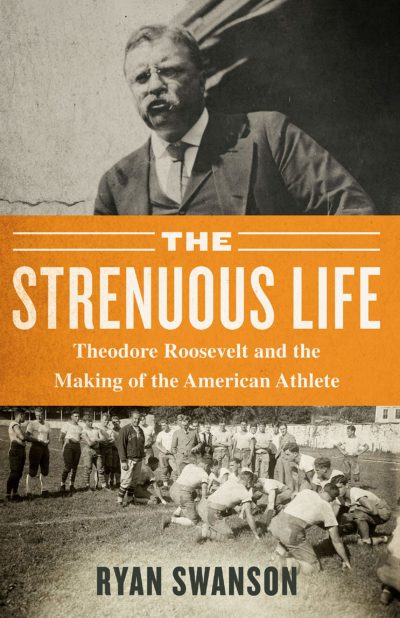The Strenuous Life: Theodore Roosevelt and the Making of the American Athlete
- By Ryan Swanson
- Diversion Books
- 336 pp.
- Reviewed by James A. Percoco
- December 27, 2019
How our 26th president ignited the modern-day wellness craze.

With The Strenuous Life, author Ryan Swanson has delivered a fresh and robust look at one of the most written about characters from American history, Theodore Roosevelt. Swanson’s book centers around what an active, sportsman’s life meant to the president and, subsequently, the nation.
It’s all here: Roosevelt’s love of football, his action on the White House tennis court he had erected, his numerous jaunts through Washington, DC’s Rock Creek Park with exhausted aides and foreign diplomats by his side, and his outdoor romps with his children on his Long Island estate, Sagamore Hill.
Roosevelt’s purpose was both to build his children up and to serve as a model for the nation and an eager press. He called his philosophy “the Strenuous life,” and wore a particular outfit when living it: “a brown army shirt, thick well-worn khaki knickers, and black boots.”
The author’s genius lies in the way he uses Roosevelt’s philosophy to depict a dynamic and changing America at the turn of the last century, a century ushered in by Teddy Roosevelt himself. This book is more than just a slice of a president’s life; it’s a social history of the era.
While Swanson is an unabashed Roosevelt enthusiast, he — like his pugilist subject — pulls no punches when it comes to the man’s shortcomings, particularly with regard to race. He is quick to note Roosevelt’s fondness for Anglo-Saxons over people of color, and even delves into Roosevelt’s handling of the sordid Brownsville Affair, a nadir of race relations wherein the commander-in-chief summarily dishonorably discharged from the U.S. Army 167 African-American soldiers stationed in Texas. Why? Mostly because the local white community wanted them gone.
Though it might seem odd to include such an ugly chapter in this particular book, the incident addresses an important element of Roosevelt’s attitude toward race — one that he applied both to athletics and governing. His personal brand of Social Darwinism ruled politics and the playing field.
Swanson clearly knows his subject. The Strenuous Life is well researched and full of humor. The tales of Roosevelt’s excursions through Rock Creek Park, no matter the weather, leave readers empathizing with those selected to walk with him. It was considered a great honor to be invited on such a ramble, but oftentimes, those less fit than the president struggled to keep up. (And many were confounded when induced to climb one of the park’s prolific rocky escarpments.)
To be considered a member of Roosevelt’s “Tennis Cabinet” was an equal honor, but those selected to play against the man-child chief executive had to endure his crushing serves and equally powerful returns. It got so that visitors to the White House on official business never knew how to dress, for they might find themselves pulled into an unexpected tennis match.
Major League Baseball was fit to be tied that Roosevelt had no interest in the then-burgeoning sport. To Roosevelt, baseball was a mollycoddle pursuit (read: effeminate). So upset were MLB executives by the snub that, in 1906 and 1907, they organized “the Great Baseball Chase,” providing the president with a golden pass to attend any pro game, anywhere, at any time. To the league’s chagrin, Roosevelt never used it.
The roots of the president’s “strenuous life” outlook sprung from childhood, when the sickly boy with asthma and poor vision was told by his father, “Theodore, you have the mind, but not the body. You must make your body equal to your mind.” To help him do just that, the elder Roosevelt built a gymnasium in their New York City brownstone, where his son learned to box and build his muscles. Teddy Roosevelt continued working out until his death, at age 60, in 1919.
In The Strenuous Life, Ryan Swanson does a superb job of illuminating how America’s 26th president helped propel the concept of “wellness” long before it was fashionable, during an era when modern sports was still in its infancy. The press of the day gobbled up Roosevelt’s practices and pronouncements, and history buffs will likely gobble up this book.
James A. Percoco is the history chair at LSG: The School for Advanced Studies in Ashburn, Virginia, and the author of Summers with Lincoln: Looking for the Man in the Monuments (Fordham, 2008).

